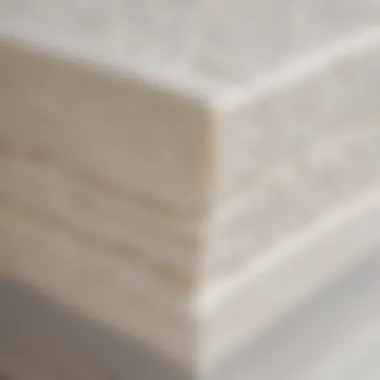Explore the Benefits of Hard Foam Mattresses


Intro
The topic of hard foam mattresses has grown increasingly prominent in discussions surrounding sleep quality and overall comfort. As homeowners and interior designers alike look for innovative ways to enhance their living spaces, understanding the nuances of these mattresses becomes crucial. Not all mattresses are created equal, and hard foam varieties bring a unique set of characteristics that cater to different sleeping preferences. This article aims to dissect the complexities surrounding hard foam mattresses, shedding light on their construction, design, and how they impact sleep quality.
In an age where comfort meets style, these mattresses stand as viable options for various furniture designs. They not only support physical well-being but also harmonize with aesthetic choices throughout a home—whether it’s a minimalist apartment or a cozy, rustic cabin. In the following sections, we’ll examine the different factors to consider, from firmness preferences to maintenance tips, that assist readers in making informed decisions. Readers will find insightful information tailored to their specific needs, whether they be a seasoned designer or someone just beginning to venture into home decor.
Furniture Design Styles
Overview of Popular Styles
When it comes to integrating hard foam mattresses into your living space, it’s essential to consider the underlying design style of your home. Popular styles like modern, Bohemian, and Scandinavian can all accommodate hard foam mattresses seamlessly, but each brings its own flair.
- Modern Design: Characterized by clean lines and minimalistic details, here, hard foam mattresses can serve as a staple. The simplicity of the mattress allows it to blend in while providing strong support.
- Bohemian Style: For those with a love for eclectic and artsy arrangements, hard foam mattresses lend themselves well to layered bedding and vibrant colors. A firm mattress can contrast the softness of throws and pillows, balancing the overall aesthetic.
- Scandinavian Design: Known for functionality, hard foam mattresses fit perfectly within this realm. They not only ensure a good night’s sleep but also align with the ethos of simplicity and natural materials found in Scandinavian homes.
How to Mix and Match Styles
Mixing and matching design styles isn't a daunting task if you're equipped with a few essential principles:
- Evaluate Your Space: Look around at the prevalent hues and shapes. A hard foam mattress can blend in; just choose complementary colors for sheets and covers.
- Layer Textures: Combining different fabrics can create layers of comfort and style. Pairing a hard foam mattress with plush pillows and textured blankets can add depth to your room's design.
- Focus on Functionality: Ultimately, your choice should align with how you wish to utilize the space. If you prioritize comfort, a solid mattress complements various interior looks.
“Form follows function—that has been misunderstood. Form and function should be one, joined in a spiritual union.” — Frank Lloyd Wright
Practical Tips for Homeowners
Essential Buying Tips
When considering the purchase of a hard foam mattress, several factors come into play that can impact your decision:
- Firmness Level: Know your preference. Ranging from firm to extra-firm, the choice impacts sleep quality and spinal alignment.
- Density Matters: A mattress that balances comfort and support should have an appropriate density, offering durability and stability over time.
- Trial Period: Don’t hesitate to inquire about trial periods. Many retailers offer a chance to test the mattress, ensuring that it suits your sleeping style.
Maintenance and Care Guidelines
Maintaining a hard foam mattress is key to prolonging its lifespan.
- Regular Rotation: Rotate the mattress every three to six months for even wear. This practice helps in preserving its structure.
- Spot Clean: Use mild soap and water for accident clean-ups. Avoid soaking the mattress; instead, dab excess moisture with a clean cloth.
- Proper Bedding: Choose the right fitted sheets and avoid excessive heat, as its too much exposure can affect the foam quality.
With these tips in mind, selecting and caring for a hard foam mattress not only enhances sleep comfort but also complements the broader design themes in any home. By tailoring these mattresses to individual styles, you create spaces that resonate on both an aesthetic and functional level.
Prelims to Hard Foam Mattresses
In the realm of sleep surfaces, the hard foam mattress has garnered notable attention among both homeowners and decorators. But what exactly serves as the foundation of its popularity? This section aims to clarify the significance of hard foam mattresses and provide insights into the various benefits and considerations one should keep in mind when exploring this bedding option.
Importance of Hard Foam Mattresses
Hard foam mattresses represent a unique intersection of support and comfort. Unlike their softer counterparts, these mattresses offer a firmer sleeping surface, which can be beneficial for those seeking spinal alignment support. Many people are waking up to the realization that a mattress’s firmness can greatly influence sleep quality, as well as overall health.
When you think about it, a good night's sleep isn't just about drifting off into slumber; it's about staying that way throughout the night without tossing and turning due to discomfort. Hard foam mattresses cater to this need by providing a stable surface that adapts to body weight without excessive sinkage.
One can't forget the practical side of things—durability plays a crucial role in the decision-making process for many. Generally, hard foam mattresses are known for their durability. They tend to hold their shape for a longer period compared to other types, making them a cost-effective investment for those who wish to see longevity in their purchase.
Additionally, hard foam systems can often be lightweight and easier to handle during setup and maintenance. This makes them a favored choice for DIYers as well.
Key Benefits and Considerations
- Support: A primary advantage of hard foam mattresses is their ability to offer firm support. This is particularly valuable for back sleepers and individuals with specific spinal issues.
- Maintenance: Hard foam mattresses typically require less upkeep than traditional innerspring mattresses. To maintain the integrity, one only needs to occasionally clean the surfaces and rotate the mattress occasionally.
- Temperature Control: While many foam mattresses are known for heat retention, hard foam versions may have better airflow due to their denser structure.
- Environmental Impact: For those concerned with materials' impact on nature, many manufacturers are offering eco-friendly options made from sustainable materials.
However, it’s also vital to consider that transitioning to a hard foam mattress may come with an adjustment period for some individuals. As a general rule, it might take time for your body to acclimate to the firmness.
Overall, as you dive deeper into the intricacies of the hard foam mattress landscape through this guide, you will uncover countless elements that make this topic not only pertinent but indispensable for anyone looking to enhance their sleep experience.
"Investing in a quality mattress is nothing short of investing in your well-being."
By understanding the contours of hard foam mattresses, you're poised to enrich your living space with a choice that complements not only aesthetics but promotes your health as well.
Defining Hard Foam
Hard foam mattresses have carved a niche for themselves in the world of sleep solutions, but what exactly defines hard foam? Understanding this material and its properties is crucial for anyone looking to invest in a quality mattress. The overall firmness, durability, and support of a mattress largely depend on how well the material is crafted and its intrinsic characteristics. With myriads of options out there, a clear comprehension of hard foam lays the groundwork for making an informed decision.
Material Composition
When we talk about hard foam, we delve into its material composition. Typically, these mattresses are made from polyurethane foam or a variation known as High-Resilience (HR) foam. The blend of chemicals used in the production allows the creation of a dense, supportive surface that can withstand pressure without sagging over time.
A few key points about the material:
- Polyurethane Foam: This type is often found in mattresses, known for its versatility and affordability. It has varying densities and firmness levels, which play a significant role in how it feels under weight.
- High-Resilience Foam: Considered a premium option, HR foam exhibits superior elasticity and durability. It tends to recover its shape more effectively, giving it a reputation for better support and longevity.
- Blends and Additives: Some manufacturers incorporate gel beads or natural latex to enhance breathability or cooling properties, vital for those sensitive to heat retention.
Choosing a hard foam mattress largely hinges on understanding these compositions, as it influences not only comfort but also how well the mattress aligns with individual sleep needs.
Production Techniques
The intricacies extend into the production techniques involved in creating hard foam mattresses. These processes reveal the complexity behind a seemingly straightforward material. The production typically follows several key procedures:
- Foam Formulation: The initial step combines polyols and isocyanates to create the raw foam material. Specific ratios impact firmness and density.
- Foaming Process: This is where the mixture undergoes chemical reactions, expanding and solidifying into foam. Depending on the intended use, manufacturers might control density and firmness through temperature adjustments.
- Cutting and Shaping: Once the foam cures, it's sliced and shaped into mattress forms. Advanced technology allows for customizable sizes and ergonomic shapes to cater to various sleeping preferences.
- Quality Assurance: Before reaching consumers, mattresses go through rigorous testing. This includes assessing durability, firmness, and even health standards to ensure safety and performance.
Understanding these production techniques gives consumers an insight into what goes into making their mattresses, reassuring them that they are investing in quality and thoughtful design.
Comparative Firmness Levels in Mattresses
When diving into the world of hard foam mattresses, understanding firmness levels becomes crucial. Firmness, often evaluated on a scale from 1 to 10, helps consumers decide which mattress suits their personal preferences and sleeping styles. This guide explores how firmness affects sleep quality, health, and overall comfort, particularly focusing on hard foam options.
Understanding Firmness Ratings
Firmness ratings can be somewhat like trying on shoes. Some may feel a perfect fit right off the bat, while others might require a few laps around the store before deciding what works. The idea is simple: a mattress that feels too soft may lead to misalignment of the spine, while one that's too hard could create pressure points.
For hard foam mattresses, firmness ratings typically hover between 6 and 8. Here’s why that matters:
- Spinal Alignment: A medium-firm mattress supports the natural curve of your spine, preventing discomfort during long nights.
- Pressure Relief: Some firmness allows for a slight give, which can ease pressure on joints without sacrificing support.
- Durability: Hard foam often retains its shape longer than softer counterparts, ensuring that its firmness remains stable over time.
Sleepers of varying styles might find these firmness ratings further dissected into categories:


- Back sleepers often benefit from medium to firm ratings, keeping the spine aligned.
- Side sleepers may prefer a softer feel to cradle the shoulders and hips.
- Stomach sleepers typically lean towards firmer choices to avoid sinking too deeply.
In essence, understanding firmness ratings isn’t merely about comfort; it’s a pathway to better sleep quality and a healthier lifestyle.
Hard Foam vs. Other Materials
When comparing hard foam mattresses with other common materials, it’s essential to consider how each type meets the needs of different sleepers.
For instance, viscoelastic memory foam, while popular for its contouring capabilities, may not provide the same level of support as hard foam. It tends to absorb heat, which can lead to discomfort for some people, especially hot sleepers.
Conversely, innerspring mattresses may offer a bouncier feel but often lack the body-contouring advantages found in high-density foams. Here are several factors that set hard foam apart:
- Supportive Structure: Hard foam’s dense materials contribute to stability and consistent support, a quality often unmatched by softer foams.
- Breathability: Many hard foam mattresses incorporate designs that enhance airflow, making them cooler than memory foams and hybrid models.
- Life Span: Hard foam is built to endure. With proper care, these mattresses might outlast their softer cousins, adding longevity to their appeal.
Ultimately, the choice between hard foam and other materials boils down to personal preference, sleeping style, and health considerations. Knowing what each option can offer allows consumers to make informed decisions that cater to their unique needs.
Benefits of Hard Foam Mattresses
Choosing a mattress is not just about comfort. It's about finding the right support to enhance your sleep quality and overall well-being. Hard foam mattresses come with an array of benefits that make them a strong contender in the mattress market. This section outlines the crucial contributions these mattresses make to your sleep experience and why they should be on your radar.
Support and Alignment
One of the standout features of hard foam mattresses is their ability to provide excellent support and alignment. Unlike softer options that tend to sink under the body’s weight, hard foam maintains a level firmness that encourages a neutral spinal position. This support can particularly benefit back sleepers, who often find that their spine is better aligned on a firmer surface.
- Enhanced Spinal Health: Well-aligned spines lead to less back pain and discomfort.
- Pressure Relief: Hard foam mattresses distribute body weight evenly, reducing the risk of pressure points forming, especially for those who sleep on their side.
When we consider the overall wellness, maintaining proper posture while sleeping can hold significant health benefits over time, making this an important factor worth considering.
Durability and Longevity
Hard foam mattresses are known for their durability. Unlike traditional spring mattresses, which may sag or lose firmness over time, hard foam maintains its shape and support with minimal degradation. Essentially, these mattresses are built to last.
- Resistance to Wear: Hard foam is less prone to indentations compared to softer materials.
- Long-term Investment: Though they might have a higher upfront cost, their longevity means they can often end up being more cost-effective in the long run.
When homeowners decide on hard foam, they are investing in high-quality sleep that doesn’t come with a short shelf life. It’s not just a bed; it’s a solid foundation that supports countless nights of restorative sleep.
Cost-Effectiveness
At first glance, some might wonder why invest in a hard foam mattress when options are notably cheaper. However, if we dig a little deeper, the logic becomes clearer.
- Lower Maintenance Costs: Due to their durability, these mattresses require less frequent replacement, ultimately saving you money year after year.
- Versatile Design Options: Many hard foam mattresses are designed with eco-friendly materials, which can enhance resale value and appeal to environmentally conscious buyers.
By investing in a hard foam mattress, you’re likely gaining a product that pays for itself over time not only in comfort but in its resilience and cost-effectiveness.
Investing in a hard foam mattress is more than just a choice; it’s a commitment to better sleep and overall health.
Overall, the benefits of hard foam mattresses extend beyond mere comfort; they foster health, durability, and long-term savings, making them not just a wise choice, but an essential one for those serious about sleep.
Potential Drawbacks of Hard Foam Mattresses
While hard foam mattresses offer a range of benefits, they aren't without their drawbacks. It’s crucial for potential buyers to be aware of certain limitations to ensure they make an informed decision. This section will dive into two significant issues: heat retention and the adjustment period, both of which can influence the overall sleeping experience.
Heat Retention Issues
One common complaint regarding hard foam mattresses is heat retention. Unlike traditional innerspring mattresses that allow for airflow, hard foam can trap heat. This builds up a feeling of warmth that might be uncomfortable for some users, especially during warmer months or for those who tend to sleep hot. The material itself can absorb heat and not dissipate it effectively, leading to an uncomfortable sleeping environment.
To mitigate this issue, newer models of hard foam mattresses often incorporate cooling technologies. These might include gel-infused foam or breathable covers designed to promote airflow. If you're in the market for a new mattress, checking for such features can be a smart move.
"If you’re a hot sleeper, you might want to look for models that specifically address heat retention. Comfort is key!"
Adjustment Period
Another potential drawback lies in the adjustment period. Transitioning to a hard foam mattress can take time, especially if you’re coming from a softer sleeping surface. Initially, users might feel a lack of immediate comfort as their bodies adapt to the new firmness. This adjustment phase can lead to discomfort during sleep, which can be problematic for individuals with pre-existing sleep issues or body pains.
Typically, it can take anywhere from a few days to a few weeks to get used to your new mattress. During this time, it’s recommended to give your body time to adapt. However, if discomfort persists beyond that period, it could signal that the mattress is not the right fit for your sleeping style.
When considering a hard foam mattress, it's beneficial to test it in-store whenever possible. Not all mattresses will suit every sleeper, and personal preferences play a massive role in comfort.
Sleep Styles and Hard Foam Compatibility
When it comes to choosing a mattress, understanding how different sleep styles interact with hard foam mattresses is key. Sleep position matters significantly in how the mattress performs and how well it meets your individual needs. Hard foam mattresses offer a specific firmness and support level that can either enhance or hinder sleep quality depending on whether you are a back, side, or stomach sleeper. This section will break down these compatibilities, examining the necessary elements to consider for each style of sleep and the individual benefits hard foam may provide.
Back Sleepers
For individuals who prefer sleeping on their backs, hard foam mattresses tend to offer excellent support. A firm surface helps maintain the spine's natural alignment, reducing the risk of back pain. Unlike softer mattresses that can cause the body to sink in too deeply, a hard foam mattress supports the natural curvature of the spine. This is particularly essential if you’re dealing with any pre-existing conditions, as it promotes proper posture while sleeping.
Benefits for Back Sleepers:
- Spinal Support: The firmness ensures that your lower back is not overly compressed, aiding in the maintenance of proper alignment.
- Pressure Distribution: Hard foam provides uniform support that can mitigate pressure points in areas like the lower back and shoulders.
However, not all hard foam mattresses are created equal, and it's advisable for back sleepers to test the mattress in-store, if possible. Spending time on the mattress in a position that mimics your sleep style can let you gauge how comfortable and supportive it feels.
Side Sleepers
Side sleepers face a different set of challenges and considerations. Generally, they require more cushioning around the hips and shoulders to prevent pressure build-up. While some may assume that hard foam would be too rigid for this style, the balance lies within the right choice of hardness level.
In practice, many hard foam mattresses are designed to accommodate side sleepers by offering an initial layer that could be softer, delivering cushioning while providing a supportive core beneath.
Key Considerations for Side Sleepers:
- Pressure Relief: Hard foam can be constructed to meet firmness while also possessing layers designed specifically to cradle areas that tend to bear more weight.
- Edge Support: A sturdy edge support helps in getting in and out of bed, which is advantageous for side sleepers who may shift positions during the night.
It’s often said that if you sleep on your side, you’ll want a mattress that doesn't feel like a block of concrete. Test mattresses with a bit of give to ensure comfort without compromising support.
Stomach Sleepers
Stomach sleepers may have the most complex interaction with hard foam mattresses. This sleeping position can place considerable strain on the back and neck, particularly if the mattress doesn't provide sufficient support. For stomach sleepers, a hard foam mattress could be ideal, as it prevents the hips from sinking too far down, which would result in misalignment.
Benefits for Stomach Sleepers:
- Position Maintenance: A firmer mattress helps keep the body aligned in a straight line, reducing stress on the spine during sleep.
- Minimal Sinkage: The rigid surface can prevent the commonly experienced issue of the stomach sinking, which oftentimes leads to discomfort and pain upon waking.


It's crucial for stomach sleepers to take extra care when selecting a hard foam mattress; testing for both firmness and how the mattress handles body contours is essential. Look for mattresses specifically marketed as suitable for stomach sleeping, as they will often have a construction tailored for that purpose.
Each sleep style demands a unique kind of support, and understanding how hard foam provides this can be the difference between restful nights and sleepless tossing.
Health Considerations Linked to Hard Foam Mattresses
When it comes to sleep, health is a prime concern, so this section unpacks the vital connections between hard foam mattresses and well-being. A good night's rest is often tied closely to the quality of the mattress one sleeps on. Understanding how hard foam mattresses can influence health—especially spinal health and sensitivity to allergens—is crucial. As such, knowledge about how these aspects impact an individual’s experience can lead to better choices, enhancing overall satisfaction and comfort.
Spinal Health
The spine is a delicate structure, with the vertebrae working together to provide support, flexibility, and shock absorption. A mattress that offers the right amount of firmness and support can keep the spine aligned while sleeping. Hard foam mattresses tend to deliver even support across the body. When people sleep on softer surfaces, their spines can sink disproportionately, leading to misalignment.
Consider this: a medium-firm hard foam mattress molds to the sleeper’s body while keeping the spine in a neutral position. A good way to check spinal alignment is to lay on the mattress and see if a straight line can be drawn along the spine from head to hips.
Proper spinal alignment during sleep can potentially reduce chronic pain in the back and neck.
The significance of hard foam mattress design cannot be overstated. They can provide crucial support for different sleeping positions. Given that many adults spend one-third of their life in bed, the importance of spinal health can’t be brushed aside.
- Back Sleepers: Typically see the most benefit, as a firm mattress prevents the midsection from sagging.
- Side Sleepers: May need to seek a balance, as excessive firmness can lead to pressure points at the shoulders and hips.
- Stomach Sleepers: Require a firmer surface to prevent the hips from sinking, as this can create a bowing effect on the spine.
In summary, when selecting a hard foam mattress, one should assess its firmness to ensure it adheres to individual preferences while promoting appropriate spinal health.
Allergies and Sensitivities
The quality of sleep can be heavily influenced by the environment in which one sleeps, including any allergens present in the bedding. Hard foam mattresses often have less tendency to harbor dust mites and similar irritants compared to traditional spring mattresses. Their material composition usually plays a part as well—if the foam is made from hypoallergenic materials, it can offer those with allergies a better experience.
Additionally, many consumers are concerned about off-gassing when they first get a mattress. Hard foam mattresses might still give off certain odors post-production, but many brands have started to use low-VOC (volatile organic compound) materials that reduce this effect considerably. It's worth noting:
- Memory foam may trap heat and moisture unless properly ventilated.
- Latex options within the hard foam category are generally hypoallergenic and resistant to mold and dust mites.
When purchasing a hard foam mattress, it is vital to consider the materials used to ensure they align with any health concerns like allergies or sensitivities. Something as simple as checking for certifications like CertiPUR-US can give consumers peace of mind about their investment.
Choosing the Right Hard Foam Mattress
Selecting the right hard foam mattress can be a rather daunting task, especially with all the choices out there. Yet, this is an essential step for ensuring a good night’s sleep. A mattress isn’t just a sleeping surface; it plays a crucial role in your overall sleep quality and physical well-being. These choices hinge not only on personal comfort preferences but also on health considerations, cost, and alignment with your lifestyle needs. Making the right decision can lead to better health, while a wrong choice may result in discomfort and sleepless nights. Here, we will delve into specific elements that are vital for choosing the right hard foam mattress.
Identifying Your Sleeping Needs
Before diving headfirst into the mattress selection process, it’s vital to understand your own sleeping needs. This step is like checking the weather before you decide to head out for a picnic; you need to know what you’re dealing with.
- Sleeping Position: Are you a back, side, or stomach sleeper? Each position requires a different level of support to maintain spinal alignment. For instance, side sleepers might need a softer feel to cushion their hips and shoulders, while back sleepers could benefit from a firmer mattress that supports a neutral spine position.
- Body Type: Heavier individuals often require a firmer surface to avoid sinking too deep, which could lead to discomfort. Lighter individuals, on the other hand, might find that softer surfaces suit their needs better.
- Joint Pain: If you have existing joint or back issues, you should look for options that provide targeted support. Mattresses designed with specific zones can help with relieving pressure points, making them a good fit for those needing additional care.
By evaluating these needs, you create a roadmap that directs you toward the right mattress, providing clarity in a crowded market.
Testing Before Buying
When it comes to buying a mattress, many folks might skip this step, thinking it’s just a quick transaction. However, truly testing the mattress can be game-changing. Much like trying on a pair of shoes before purchasing, it’s important to physically experience the mattress before making a commitment. Here are some essential tips for maximizing your testing experience:
- Spend Time on It: Don’t just do a quick bounce; lie down on the mattress for several minutes in your preferred sleeping position. This helps you gauge comfort over time.
- Different Settings: Visit stores that allow you to test beds in various settings. Pay attention to how your body reacts in different sleeping positions on the hard foam.
- Bring a Friend: Sometimes a second opinion helps. Bring along someone who can offer advice based on their perception of comfort and support.
- Understand Return Policies: Before plunking down your cash, know the store’s policy. Many retailers offer generous trial periods that allow you to return or exchange if things don’t work out.
By taking these steps, you ensure that you choose a hard foam mattress that not only fits your needs but also aligns perfectly with your lifestyle.
Caring for Your Hard Foam Mattress
When it comes to hard foam mattresses, proper care and maintenance can significantly extend their life and ensure they remain comfortable over time. The value of these mattresses, known for their solid support, can be diminished if they aren't well cared for. Keeping them clean and preventing damage not only enhances durability but also promotes a healthier sleep environment.
Cleaning Methods
Cleaning your hard foam mattress regularly is crucial for maintaining hygiene and comfort. Here are some effective methods:
- Vacuuming: Use a vacuum cleaner with an upholstery attachment. This will help you remove dust, allergens, and other debris that may have settled on the mattress surface.
- Spot Cleaning: For stains or spills, a mixture of mild detergent and water often does the trick. Dab the stained area with a cloth soaked in the mixture, but avoid soaking the foam, as excessive moisture can degrade its integrity.
- Freshening Up: To eliminate odors, sprinkle baking soda over the surface and let it sit for several hours. This natural deodorizer can help absorb unpleasant smells, leaving the mattress smelling fresh. Vacuum it up afterward.
- Deep Cleaning: Consider professional cleaning once every year or so. Specialized services can provide a thorough clean that home methods may not achieve, helping to lengthen the life of your mattress.
Preventing Damage
Taking proactive steps to prevent damage can save considerable hassle down the line. Here are some key tips for protecting your hard foam mattress:
- Use a Mattress Protector: A high-quality mattress protector can shield against spills, stains, and dust mites. It's easier to clean and can be replaced at lower cost than a mattress.
- Rotate Regularly: Rotating your mattress every few months can help ensure even wear. This simple practice can prevent body impressions from forming over time, keeping the mattress supportive.
- Avoid Excessive Weight: Placing heavy objects on the mattress without proper support can lead to indentations. Make sure you’re using a sturdy bed frame that can handle the weight.
- Keep Away from Direct Sunlight: Prolonged exposure to sunlight can cause fading and degrade foam materials. Position your mattress away from bright sunlight or use blackout curtains in the bedroom.
- Store Properly: If you are planning to store your mattress for any period, make sure it’s stored flat and in a dry environment to avoid any deformities or mold growth.
"Taking a few minutes to care for your hard foam mattress can save you both time and money in the long run. A little diligence goes a long way!"
By integrating these care and maintenance practices into your routine, you’ll enhance the lifespan and performance of your hard foam mattress. This will not only ensure a comfortable night's sleep but also contribute to better overall health and well-being.
Current Trends in Mattress Design
As the mattress industry evolves, keeping up with current trends in mattress design is crucial for both consumers and professionals in the field. These trends influence how mattresses are constructed, the materials used, and even how they fit into modern bedroom aesthetics.
One significant trend is the increased focus on customization. Consumers are no longer satisfied with a one-size-fits-all approach. Hard foam mattresses, for instance, are being tailored to meet individual needs, from specific firmness levels to unique support structures. This trend toward personalization allows for a more tailored sleeping experience, which can lead to improved sleep quality and overall health. By understanding one's own sleep preferences, designers and retailers can offer well-informed recommendations.
Innovations in Hard Foam Technology
Hard foam technology has seen remarkable innovations in recent years. Manufacturers are developing new formulations of foam that enhance durability, support, and sleep comfort. For example, there is a growing trend in the use of open-cell foam structures. These structures provide better airflow compared to traditional closed-cell options. The benefit? Enhanced breathability that can minimize heat retention—a common issue with foam mattresses.
Another exciting innovation includes the integration of adaptive materials that adjust to the body’s sleeping position. These technologies have resulted in mattresses that offer personalized support without compromising on firmness. This means that whether one is a back sleeper or a stomach sleeper, they can find a mattress that adapts to their needs.
"A mattress isn't just a place to sleep; it's an investment in health and happiness."
Eco-Friendly Material Options
The trend of sustainability heavily influences mattress design nowadays, particularly for hard foam mattresses. An increasing number of brands are recognizing the importance of eco-friendly material options. Consumers today are more mindful of their purchases and are inclined to choose products that align with their sustainability values.
There are several eco-conscious alternatives in the market. For instance, biodegradable foams have started gaining traction. These materials break down more easily than traditional foams, thus reducing landfill waste. Additionally, some companies utilize natural latex derived from rubber trees, which is not only supportive but also biodegradable.
Furthermore, many manufacturers are committed to sourcing sustainable materials without compromising on comfort or quality. This includes using breathable organic cotton covers and non-toxic adhesives in their production processes.
It's important to consider these options if you are looking to make a conscious choice while purchasing a mattress.
By being aware of these current trends, consumers and industry experts alike can make informed decisions that not only contribute to personal well-being but also to a healthier planet. Choosing a hard foam mattress that embraces these innovations can greatly enhance your sleep experience.
Cost Analysis of Hard Foam Mattresses


Understanding the costs associated with hard foam mattresses is vital for anyone considering a purchase. It’s not just about finding the cheapest option on the market; one should weigh the elements that contribute to the price and long-term value. After all, this investment impacts both sleep quality and overall well-being.
Understanding Price Variations
When looking at the price variations for hard foam mattresses, you might feel like you're navigating a minefield. Prices can differ significantly based on several factors. Here are some key elements affecting costs:
- Material Quality: Higher quality foam often means better durability. Cheaper foam can wear out quicker, leading to the need for replacement sooner rather than later.
- Brand Reputation: Recognized brands may have a higher price tag due to their established trust and performance record.
- Customization Options: For those wanting a tailored sleep experience, customization features can inflate prices.
- Where You Buy: Retailers’ pricing strategies can vary. Online shops might offer competitive prices, while brick-and-mortar stores might add overheads that reflect in the costs.
Price variance signifies the diverse landscape of consumer choices in the mattress market. It’s essential to take these factors into account as they guide the decision-making process when it comes to finding the right balance between quality and affordability.
Budgeting for Quality
Diving deeper into budgeting, the goal here is not just to spend less but to spend wisely. Setting a budget requires understanding both your financial limits and what quality means in the context of hard foam mattresses. Here are some pointers to help you allocate your funds effectively:
- Establish a Range: Know what you can afford. Most hard foam mattresses can range from a few hundred to over a thousand dollars. A good starting point is narrowing your options to a price range that suits your wallet.
- Prioritize Features: Decide what features are important for you—firmness level, cooling technology, or maybe eco-friendly materials. Focusing on the essentials allows you to invest in what truly matters.
- Research Financing Options: Many retailers offer financing plans which can help manage the cost over time. It’s worth looking into these plans if you find a mattress that checks all your boxes.
- Consider Lifespan: A higher upfront cost might actually save you in the long run. Investing in a durable product means you're looking at a mattress that won’t need to be replaced as often, thus reducing future expenses.
As you navigate the budgeting process, remember that a mattress is an essential element of your home, influencing not just sleep quality but your daily life as a whole.
"Quality isn't just a price tag; it’s about how well a product serves you over time."
Investing in a hard foam mattress should be viewed as a long-term benefit. The ideal approach is to marry your budget with options that will deliver exceptional comfort and support. This deliberate strategy not only ensures you get the best for your money but also enhances your sleep experience.
Mattress Lifespan and When to Replace
When it comes to hard foam mattresses, understanding their lifespan and the right time to replace them can largely impact your comfort and overall sleep quality. A mattress isn’t just a bed to lie on; it’s an investment in health and well-being. With time, even the quality of hard foam mattresses diminishes. The significance of recognizing the signs that indicate it’s time for a new mattress goes beyond mere comfort. It also encompasses physical health, sleep quality, and even the aesthetics of your bedroom space.
Signs of Wear and Tear
Not sure whether it’s time to consider replacing your mattress? Watch for these telltale signs:
- Visible Indentations: A clear sign of wear, if your mattress shows low spots where you sleep, it argues for a replacement.
- Increased Allergen Build-up: Over time, mattresses accumulate dust mites, mold, and other allergens. If you find yourself sneezing more often, it may point to an old mattress.
- Uncomfortable Sleep Experience: Waking up with aches and pains, or at strange hours because you can’t find a comfortable position? This discomfort can largely stem from a worn mattress.
- Squeaky or Noisy: If you hear sounds when shifting or getting up, it might indicate internal components are deteriorating.
If you nod your head to even one of these signs, it’s arguably time to reconsider your sleeping arrangements.
"A good night's sleep depends not only on the right bed but also the right bed that has seen better days."
Expected Lifespan of Hard Foam
On average, a hard foam mattress can last anywhere from 7 to 10 years. However, various factors can influence this lifespan:
- Quality of Foam: Premium grade foam will typically outlast its lesser counterparts. Knowing the grade of foam can give insight into expected longevity.
- Care and Maintenance: Regularly rotating the mattress, using a protective cover, and keeping it clean can significantly extend its life. Don’t neglect these simple practices.
- Usage Frequency: A mattress used nightly may wear down quicker than one in a guest room. Take into account the frequency of use in your lifespan calculations.
- Body Weight: Heavier individuals may find their mattresses degrade faster, leading to a shorter lifespan.
As an owner, keeping tabs on these factors ensures that when the time comes to replace the mattress, you make informed decisions rather than waiting till it’s obviously too late. Noting these elements can really make a difference in how long you enjoy restful nights.
Integration of Hard Foam Mattresses in Interior Design
When considering how interiors come together, mattress choices don’t usually leap to the forefront of one’s mind. Yet, the integration of hard foam mattresses into the broader design scheme of a bedroom is important because of their impact on both the aesthetic and functionality of the space. Selecting a mattress is more than just about sleep quality – it’s a decision that intertwines comfort, style, and health.
Incorporating hard foam mattresses shows a commitment to modern features while enhancing overall room appeal. With their sleek profiles and innovative designs, they complement various interior trends, from contemporary minimalism to rustic charm. Homeowners and interior designers alike can’t afford to overlook these essentials in crafting spaces that are visually pleasing as well as restful.
Matching with Bedroom Aesthetics
The aesthetics of a bedroom plays a crucial role in feeling relaxed and comfortable in that space. Hard foam mattresses, available in numerous colors, textures, and styles, can be matched aptly with the room’s decor. Whether you’re aiming for a cozy haven or an upscale hotel vibe, these mattresses can help you achieve that goal.
Here are several points to consider while matching hard foam mattresses with bedroom aesthetics:
- Color Coordination: Most hard foam mattresses come in neutral shades, which makes them adaptable to a range of color schemes. You can choose bedding that aligns with your room's palette while letting the mattress blend seamlessly into the overall theme.
- Texture Play: Pairing a hard foam mattress with soft upholstery can create delightful textural contrast. Consider how the tactile sensation of sheets and pillows work together with the mattress material to enhance coziness.
- Profile Shape: The overall height and form of a hard foam mattress can influence room proportions. Choosing a lower-profile foam mattress can lend an air of spaciousness, whereas a thicker mattress can exude luxury and presence.
- Headboard Designs: A mattress doesn’t have to sit alone. The choices made for headboards can enhance the aesthetic dramatically. For example, combining a chic hard foam mattress with a tufted velvet headboard creates a sophisticated focal point.
Complementing Other Furniture Pieces
In a well-designed space, every element has a role to play. For hard foam mattresses, complementing other furniture pieces involves careful consideration of style and function. The right pieces can amplify the mattress's benefits while contributing positively to an uncluttered visual flow.
Think about the following:
- Bed Frame Choices: A stylish bed frame can serve as an anchor for a hard foam mattress. Whether you opt for wood, metal, or upholstered frames, they have the potential to set the room's tone. For example, an industrial-style metal frame could enhance a hard foam mattress’s modern feel.
- Nightstands and Storage Pieces: When selecting nightstands or storage solutions, ensure they don't overwhelm the mattress’s streamlined design. Go for pieces that offer both form and function. For example, floating shelves or slim nightstands provide convenience without cluttering the visuals.
- Accessorizing Wisely: Accessories such as throws, pillows, and artwork should harmonize with the mattress design while adding personal flair. Keep them aligned with your bedroom’s color scheme for a put-together look.
- Coherent Color Scheme: Remember that the colors and textures of your mattress and furniture should work in concert. For example, if your hard foam mattress has a light gray hue, choosing furniture in similar or complementary shades can create a cohesive appearance.
"The right mattress will not only support sleep but also shape how a room feels and functions. It’s not simply about comfort; it’s about design integration at its finest."
Consumer Reviews: Insights and Considerations
In the world of hard foam mattresses, consumer reviews play a pivotal role. They serve as the bridge connecting potential buyers with the realities of ownership. Reviews can provide insights that advertisements won't, highlighting both the joys and pitfalls that come with these mattresses. It’s not just about the comfort promised on the label; it’s about the lived experience. This section dives into the depths of user experiences and the reputations of brands.
Assessing User Experiences
User experiences are a goldmine of information for anyone considering a hard foam mattress. They reflect a broad spectrum of opinions. Here are a few critical aspects to consider when delving into reviews:
- Comfort Level: Many users mention how well the mattress supports different sleeping positions. For instance, back sleepers often rave about spinal alignment, while side sleepers may express concerns about pressure points.
- Durability: Assess how long users report their mattresses lasting before visible wear occurs. Reviews can be illuminating here, allowing consumers to gauge if the mattress lives up to its claims.
- Adjustable Qualities: Some reviewers discuss how models with adjustable firmness can enhance or detract from their sleep experience. This can be a game-changer for couples with differing sleep preferences.
In sifting through experiences, look for patterns. If multiple sources mention the same issue with a product, it might be wise to heed that advice. Differing experiences can also provide valuable perspective; after all, personal preference is an undeniable factor in mattress choice.
Reputation of Brands
The reputation of brands specializing in hard foam mattresses can heavily influence consumer trust and purchasing decisions. It's wise to take stock of what consumers say about various brands.
- Established Brands vs. New Entrants: Established brands often come with a history of quality and reliability. However, newcomers may offer innovative features that deserve attention. Researching consumer feedback on these brands can give you a clearer picture of their standing in the market.
- Customer Service: Many reviews also touch on the effectiveness of customer service. A brand that handles issues promptly can enhance user satisfaction and foster loyalty. It’s vital to consider how a company treats its customers after the sale.
- Warranty and Return Policy: Positive reviews often highlight generous warranty offerings and easy return processes. A purchase of a mattress is an investment, and brands that back it up with promises often earn brownie points.
"Understanding consumer reviews is not a mere exercise; it's a strategic method of ensuring that you invest wisely in restful sleep that suits your needs."
In summary, consumer reviews are invaluable when evaluating hard foam mattresses. They provide insight into everyday experiences, highlighting what to expect from a mattress that may be on your radar. By balancing user experiences with brand reputation, you can make an informed decision that aligns with your sleep requirements and personal preferences.
Finale: Evaluating Hard Foam Mattresses
In wrapping up our exploration of hard foam mattresses, it becomes evident that the decision-making process for consumers is anything but straightforward. This final section emphasizes the significance of evaluating various elements that define the experience of using a hard foam mattress. It’s crucial to sift through an array of features, advantages, as well as potential drawbacks before making a purchase.
One of the main takeaways from earlier discussions is the unique ability of hard foam mattresses to provide exceptional support and alignment. This is particularly relevant for back sleepers and those who might suffer from various health conditions like chronic back pain. Proper spinal alignment not only contributes to enhanced comfort during sleep but also plays a vital role in overall health—reducing the risk of further complications arising from poor sleeping posture.
"Investing in a quality mattress can be a game changer for your well-being."
In terms of durability, hard foam mattresses tend to shine when compared to their softer counterparts. They withstand wear and tear more effectively, thereby offering a better return on investment for homeowners or renters who want something that will last. Consumers do need to be cognizant of the potential trade-off regarding temperature regulation, as some hard foam materials may trap heat more than traditional innerspring mattresses.
Moreover, evaluating a hard foam mattress includes understanding what works best based on personal sleep styles. Not every mattress suits every individual; for instance, a side sleeper might not find the firmness ideal, while a stomach sleeper needs something that provides a balance of support to maintain alignment without pushing them too high. Delving into consumer reviews often uncovers insights into real-world experiences, allowing prospective buyers to gauge satisfaction levels across various brands and models.
When it comes to aesthetics, hard foam mattresses don’t have to be a compromise. They can blend seamlessly into well-designed bedrooms, complementing a variety of styles, from modern minimalist to classic vintage. Interior designers particularly appreciate how these mattresses fit into a broader design scheme without detracting from other elements of the room.
Ultimately, as we evaluate hard foam mattresses, the goal is to combine the perceived benefits with individual needs and likes. The space where we sleep has significant consequences on our health, comfort, and even our day-to-day lives. Therefore, a thoughtful approach to this decision not only enhances one's sleeping experience but also supports better physical and mental well-being.
As we conclude this guide, readers are encouraged to weigh these aspects carefully. From firmness levels to compatibility with various sleeping styles, each factor is part of a broader picture that influences your sleep—and, by extension, your life.















